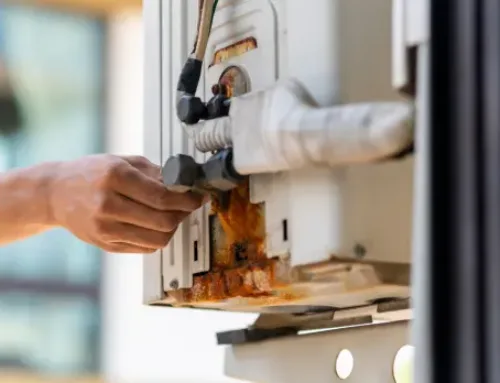Nothing is more depressing than not having sufficient hot water supply when you want to take a shower or do your dishes.
One of the reasons can be that you are using a storage water heater. The only problem with this type of water heater is that you have to wait for the water heater to fill in the water and then hit it for you.
This is where tankless water heaters come into the picture. Unlike storage water heaters, tankless water heaters do not store hot water. They heat water whenever you need it and ensure a continuous supply of hot water.
If you are planning to buy a tankless water heater for your home, this guide will help you make the best decision.
In this guide, we will cover what tankless water heaters are, how they work, how much they cost, and what size you need for your home.
Let us start with the basics.
What is a Tankless Water Heater?
Tankless water heaters, also known as demand-type water heaters, are home appliances that produce hot water on demand.
Tankless water heaters eliminate the need for costly and huge storage tanks, which means you do not have to wait for hot water while the water heater is heating it for you.
These types of water heaters are already popular in Europe, and now they are gaining popularity in Canada, where temperatures can go up to -63.0°C (-81.4°F).
Tankless water heaters can supply hot water to your entire house or a single point, like a sink or shower.
These types of water heaters are powered by three energy sources such as electricity, natural gas, or propane.
How Does a Tankless Water Heater Work?
When a hot water faucet is turned on, cold water passes through a heat exchanger in the unit, and either an electric element or natural gas burner heats the water.
As a result, tankless water heaters provide a continuous hot water supply on demand. If installed properly by a technician, you do not have to wait for a storage tank to fill up hot water and then supply it.
Should You Install a Tankless Water Heater?
Many people are arguing over whether or not I should install a tankless water heater in my house.
But according to us, it is safe to install a tankless water heater in your home. It delivers hot water whenever you need it and as long as you need which helps you save money on energy bills.
Since there is no need for a storage tank, there is no chance of catastrophic leaks. Tankless water heaters are ideal for small households or houses with limited space.
How Much Does a Tankless Water Heater Cost?
The average cost of a tankless water heater is between $3000-$5500, including installation.
Many popular brands in Canada sell tankless water heaters, such as Rinnai, EEMax, Stiebel, etc., but Navien is popular among Canadian citizens.
Factors such as the type, size, and place where you install a tankless water heater play an important role in affecting the price of tankless water heaters.
Henceforth, we advise you to consider the above factors before you decide to buy one for your house.
Pros and Cons of Tankless Water Heaters
Pros of Tankless Water Heaters
- Saves Space: A conventional storage water heater takes approximately 15-16 square feet of floor space. At the same time, many tankless water heaters take up space the size of a briefcase. This means you can install these water heaters outside or inside your house and free up a significant amount of space.
- Energy Efficient: Unlike a storage water heater that continuously heats water, a tankless water heater heats water only when necessary. This results in higher energy efficiency and lower utility bills.
- Unlimited Hot Water: Tankless water heaters heat your water whenever you require it and provide an unlimited hot water supply. In contrast, storage tank water heaters can run out of hot water and leave you with cold water before the tank heats up again.
Cons of Tankless Water Heaters
-
Higher Installation Cost: Installing a tankless water heater can be a bit pricey as there are several factors that a technician has to consider before starting the installation. The costs rely on whether you are replacing the tank-based water heater or the area of your tankless water heater.
It is advisable to not install a tankless water heater by yourself and contact a professional for the same. Many manufacturers might even void the warranty if you try to install the tankless water heater by yourself.
- Dependency on Electricity: An electric tankless water heater needs electricity to heat the water, and during power outages, you will not get a hot water supply.
-
Water Usage: If your house is using a huge amount of water, your tankless water heater may not be able to meet the hot water demand. You come across this problem only if you have chosen a tankless water heater that does not meet the water needs of your house.
You should consider the flow rate of your tankless water heater to ensure it will maintain the amount of water you generally use.
Tankless Water Heater Maintenance and Durability
In general, you should repair or service your tankless water heater once a year. If your house has a hard water supply, then we advise you to contact your HVAC technician and get it repaired every six months.
Regular maintenance guarantees that your tankless water heater is running smoothly and will save you from costly repairs.
When technicians visit your house to service or repair your tankless water heating unit, they will conduct several tasks, such as flushing out pipes leading to and from your heater.
This will help in removing any debris or buildup that might be clogging the lines. The technician will also inspect any hoses or connections for signs of leaks or damage. In addition, they will also check for any corrosion around the exterior of the heater.
When it comes to durability, tankless water heat can last longer than a traditional storage water heater. Some tankless water heaters have a life expectancy of 20 years, whereas storage water heaters have 12-15 years.
Rebates for a Tankless Water Heater
The rebates for a tankless water heater in Canada depend on the area where your house is located. Generally, you get $1000 to $5600 rebates for your tankless water heater. To know the exact amount of the rebates, you must contact a professional or manufacturer.
What Size Tankless Water Heater Do I Need?
You should always consider two factors when buying a tankless water heater for your house, i.e., temperature rise and flow rate. Understanding these specifications will help you choose a water heater that caters to your hot water needs.
Flow Rate
The flow rate means the amount of water the water heater can produce per minute. It is generally measured in gallons per minute and can change from model to model.
To determine the appropriate flow rate for your home, consider the total number of hot water outlets that will be using hot water simultaneously.
Common hot water appliances include faucets, washing machines, showers, and dishwashers. All of these have a particular flow rate need.
To calculate the flow rate, you must consider the number of appliances that need hot water. For instance, a shower generally uses 2.5 GPM (Gallon Per Minute), and a washing machine uses 2 GPM. If two people are using the shower simultaneously and a washing machine is also running, you will need a tankless water heater with a flow rate of 7 GPM.
Temperature Rise
In simple terms, the temperature rise is the difference between the temperature of the incoming water and the desired hot water temperature.
Tankless water heaters are designed to offer a particular temperature rise at a given flow rate.
To determine the required temperature rise for your unit, you must consider your climate and the desired hot water temperature.
In Canada, generally, the incoming water temperature is around 5 °C during winter. To determine the optimal temperature rise for your house, subtract the incoming water temperature from the required output temperature.
For example, if you need an output temperature of 120°F and the incoming water temperature is 20°F, the temperature rise is 100°F. This means you will have to buy a tankless water heater that can give a temperature rise of at least 80-90°F at the desired flow rate.
How to Install a Tankless Water Heater?
Installing a tankless water heater is a dangerous job, and you should not take it up as a do-it-yourself project.
In this process, your house might need upgrades such as new gas lines or wiring to accommodate a new water heater. Hence, you should contact licensed HVAC professionals and plumbers to do this job.
These professionals will install your tankless water heater while catering to all local plumbing and electrical codes and permits, including carbon monoxide emissions, thermal resistance, venting, etc.
Still, let’s understand how to install a tankless water heater so that you get a basic idea about it.
- Switch off Circuit Breaker, Water, and Gas Supply: Before starting the installation of your tankless water heater, it is important to switch off the circuit breaker and turn off the gas supply as well. You should do this to ensure that the electric cables are not powered, or the gas supply is off when you are installing the unit.
- Drain the Old Water Heater: For this, you will need a hose and a container, like a bucket. Open a hot water faucet to release pressure in the unit and allow it to drain out completely. Unscrew the connecting pipes before you remove the old wiring and wall-mounting brackets.
- Mount the Water Heater: When mounting your tankless water heater unit to a wall, ensure the water heater is not placed in a cluttered or messy area of your house. It is also important to have easy access to the unit in the event of an emergency.
- Connect Any Pipes: After mounting your water heater, you have to connect the pipes that distribute hot water into your house. These connections will go in and out of your unit. They must be located towards the bottom of the unit.
- Install Flow and Pressure Valves: Once you have connected the pipe, it is time to install the flow and pressure valves. Flow valves are easy to install and allow you to turn off the water supply to the heater when repairs are required rather than having to shut off the water supply to your entire house.
-
Turn on the Water: Now, your tankless water heater should be connected and fully installed. However, you will still have to perform the bleeding process before you turn the hot water system on.
All hot water outlets in your house must be opened, which helps remove air from the system. Keep these outlets open for several minutes, after which the bleeding process should be completed.
Final Thoughts
Tankless water heaters are the best alternative to storage water heaters. They can give you unlimited hot water on demand and are highly efficient.
Before installing one at your house, you must consider various factors such as the type of construction, climate of your region, household lifestyle, number of appliances you need hot water for, etc.
Moreover, the durability of tankless water heaters is higher compared to tank-based water heaters.
We at Infiniti Home Comfort offer world-class tankless water heater boiler installation services. We have a team of skilled HVAC professionals who will install or repair tankless water boilers so you never run out of hot water. Contact us today to get the best HVAC services in Canada.




